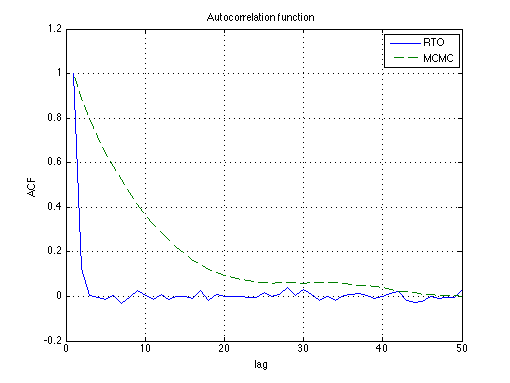RTO with BOD model
We use RTO to sample parameters in

with data:
x = [1 3 5 7 9]'; y = [0.076 0.258 0.369 0.492 0.559]'; sig = 0.0136; % known obs error (MSE from fit) th = [0.9294 0.1040]; % LSQ fit with fixed data
model, jac, residual fcn
f = @(x,th) th(1)*(1-exp(-th(2)*x)); j = @(x,th) [1-exp(-th(2)*x) th(1)*x.*exp(-th(2)*x)]./sig; resf = @(x,y,th) (y-f(x,th))/sig;
Initial MAP fit
th = lsqlevmar(@(th)resf(x,y,th), @(th)j(x,th), th);
save Q from qr decomposition of Jac at MAP
[Q0,~] = qr(j(x,th),0);
RTO sampling
nsimu = 5000; % no. of samples thsim = zeros(nsimu,2); % space for the chain log_imp_wts=zeros(nsimu,1); % space for log of weights h = waitbar(0,'Doing RTO simulation...'); for i=1:nsimu % show progress if fix(i/100) == i/100;waitbar(i/nsimu,h);end % randomize ... ys = y+randn(size(y))*sig; % then optimize thsim(i,:) = lsqlevmar(@(th)Q0'*resf(x,ys,th),@(th)Q0'*j(x,th),th); % Jacobian and residuals at the new sample J = j(x,thsim(i,:)); resid = resf(x,y,thsim(i,:)); % compute correction factor, eqn (3.7) in the paper log_imp_wts(i) = rtodetlog(J,resid,Q0); end delete(h);
post-process and plot the results
acce = rtoaccept_log(log_imp_wts); % Metropolis-Hastings
thsimfix = thsim(acce,:);
plotting
figure(1);clf plot(thsimfix(:,1),thsimfix(:,2),'.r'); xlabel('\theta_1');ylabel('\theta_2');

MCMC sampling with DRAM. We simulate from the posterior distribution using MCMC with the DRAM algorithm.
J0 = j(x,th); qcov = inv(J0'*J0); % initial proposal covariance [res,chain] = mcmcrun(struct('ssfun',@(th,d)sum(resf(x,y,th).^2)),... [],... {{'\theta_1',th(1)},{'\theta_2',th(2)}},... struct('nsimu',nsimu,'qcov',qcov));
Sampling these parameters: name start [min,max] N(mu,s^2) \theta_1: 0.929369 [-Inf,Inf] N(0,Inf) \theta_2: 0.103995 [-Inf,Inf] N(0,Inf)
figure(1) hold on plot(chain(:,1),chain(:,2),'.b'); hold off legend('RTO','MCMC')

RTO simulation takes more time than MCMC, but from the autocorrelation function, we see that RTO is about 25 times more efficient that MCMC.
figure(2);clf plot(1:50,acf(thsimfix(:,1),49),'-',1:50,acf(chain(:,1),49),'--') grid; xlabel('lag'),ylabel('ACF'); title('Autocorrelation function'); legend('RTO','MCMC')
